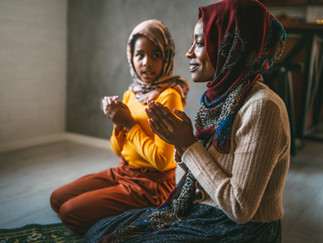Religious Trauma and Attachment
- Paige Cahill

- Sep 10
- 4 min read
When we talk about religious trauma, we’re not only talking about the impact of harmful beliefs or doctrines. Those play a major role in shaping someone's concept of themselves and the world around them, of course! However, more often than not, the therapeutic conversation comes back to relationships.
This is because so much of life in religious communities is built around relationships. Relationships with family, other members of the religious community, authority figures within the religion--just to name a few. These relationships don't exist in isolation, either. The threads of connection within a religious group are often very intertwined and can run really deep. That’s why, when someone experiences religious trauma and chooses to leave--or somehow change their relationship to the organization--the loss of community and support can feel so profound. Sometimes changing one's orientation to a religious or spiritual group is misinterpreted as a personal afront or betrayal to other members, leading them to isolate or exclude the one making that change.
In therapy it makes sense then, that the loss of these connections is often one of the central themes we return to.

What's Attachment Got to do With It?
While the relationships mentioned above are undoubtedly impactful, there is perhaps no relationship quite as defining as one's relationship to a higher power(s). This might feel like an obvious statement given the outsized role that higher powers play in religious beliefs; they are, after all, who we're taught to orient our lives around. However, the depth and primacy of that relationship isn't something we all tend to fully comprehend--even when we've been involved in a religious or spiritual practice our entire lives.
Before we dive into this too deeply, I think it's important to do a quick overview of the concept of 'attachment.' Attachment Theory is a way of understanding how our earliest relationships shape us. First introduced by psychologist John Bowlby in the 1950s, it’s now one of the most widely recognized frameworks in psychology. At its core, Attachment Theory says that humans are wired to seek out strong emotional bonds, especially with caregivers who are tasked with making us feel safe, comforted, and supported.
Those first bonds become the blueprint for how we connect with others throughout our lives.
How we trust, relate, and respond to others--whether it’s a partner, child, close friend, or even a mentor--will typically mirror the patterns we first learned as kids. Having a strong, supportive attachment figure early in life can make a huge difference. When caregivers are reliable, responsive, and emotionally available, we learn to trust others, feel secure in relationships, and navigate life’s ups and downs with confidence. On the other hand, if caregivers are inconsistent, distant, or harsh, it can leave us feeling anxious, avoidant, or unsure of how to connect.
How Understanding Attachment Can Help us Heal from Religious Trauma
Maybe you’re starting to see where I’m going with this. Because we were taught to seek some level of security from them, the higher powers we believe in also function as attachment figures. And, just like with other attachment figures, the nature of our relationship to a higher power(s) can have a profound impact on our attachment style. If the attachment figure we were taught to trust is harsh, critical, unpredictable, or distant, that can cause some significant harm. It can leave us feeling ashamed, guilty, fearful, and as though we're trapped in a constant loop of trying to earn comfort and security from a figure that we're consistently told doesn’t approve of us. This, in turn, can shape the way we relate to other important people in our lives. For example, we might feel a deep, insatiable desire for close connections, but simultaneously push away those who make an earnest attempt to get close to us because we believe we're unlovable or are just waiting for the other shoe to drop.
That’s why healing from religious trauma often involves exploring not just beliefs, but the emotional bond we’ve formed with the divine, and ultimately learning how to renegotiate that relationship in a way that feels safe and nurturing.
In therapy, I often start by noticing and naming this particular relationship—how it mirrors earlier attachment experiences, both the supportive and the hurtful. From there, we begin to untangle your experience: identifying any comforting aspects of faith (and it’s completely valid if there aren’t any), separating them from the harmful ones, setting boundaries around beliefs that feel damaging, and practicing self-soothing and self-compassion. The goal is to help you rebuild a sense of security, nurturance, and safety within yourself, independent of any external authority or institution.
Ultimately, religious trauma isn’t just about beliefs or rules; it's deeply rooted in relationships, including the one we form with a higher power(s). Understanding that bond through the lens of Attachment Theory helps us see why faith can feel so comforting for some, and so painful for others. It also provides us a pathway for healing. Overcoming religious trauma doesn't necessarily mean going back to church or adopting a new set of beliefs; it’s about finding a sense of safety within yourself. By recognizing these patterns, we can start to reclaim emotional well-being, one secure connection at a time.
If this is something you're interested in exploring for yourself, or if you have someone in your life that could benefit from this type of support, I would encourage you to read my bio and complete your intake with YEG Family Counselling today.


















Comments